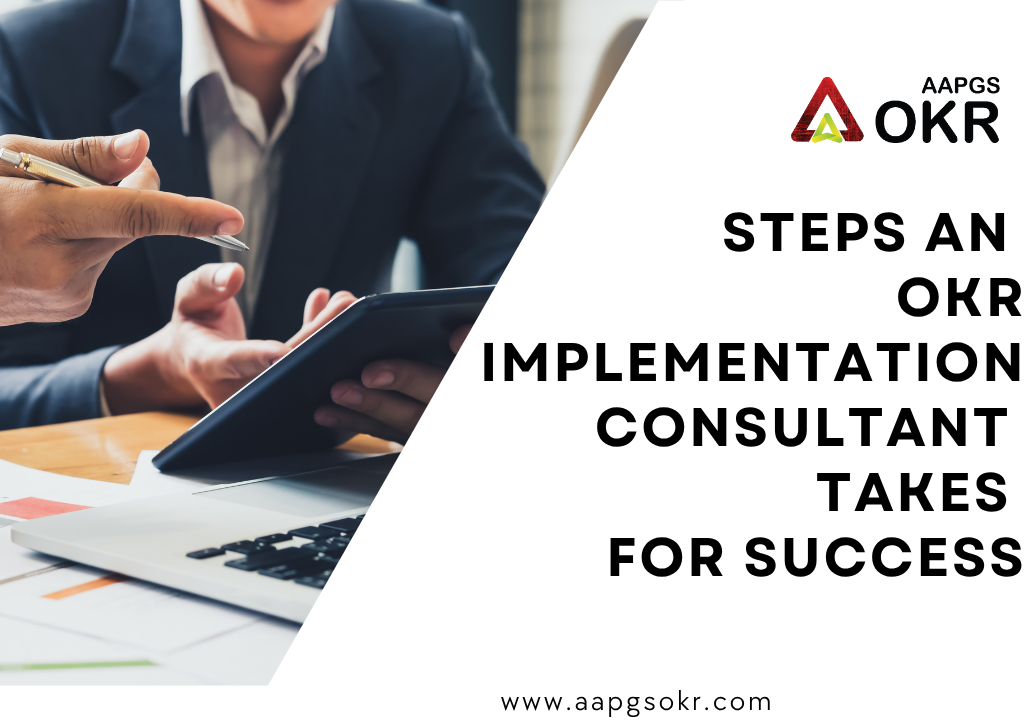The basics are clear and all requirements are met? Then it's time for planning the implementation. Introducing OKRs in organizations with several hundred or even thousand employees requires a strategy and a clear approach. Our experience at AAPGS shows that a successful OKR implementation usually takes place in eight steps.
1. Set a clear goal
- Before the implementation process is planned in concrete terms, it should be clear what goal is being pursued with the transformation.
- This does not always have to be a complete OKR rollout throughout the organization.
- In fact, two approaches are possible: becoming fully agile or going for a mixed approach.
- An organization that is strongly market-oriented and repeatedly confronted with rapid changes in the environment can benefit greatly from full agility.
- If there are divisions within the organization that can be managed more predictably, it may be wise not to work with OKRs throughout the whole organization.
2. Define the scope and parameters
Once the company's goals for the transformation are established, the next step is to define the scope for the step-by-step implementation. In this context, the following points are important:
- Area
- Duration
- Lead time
- Success criteria
- Systems
- Communication
- Meetings
3. Carefully select the pilot group
- Once the benchmarks and parameters are determined, the next step is to find the right pilot group.
- In addition to the size, it is important to create a stable base for the agile transformation,select a pilot group in which OKRs can be easily integrated into existing planning and reporting processes, and involve employees and managers from different hierarchical levels and departments, if possible.
- Finally, it is also useful to involve employees who have a general desire to contribute to the change in the company and thus become internal influencers.
4. Get all important people involved early
- An important part of planning is answering the following question early on: Who should be involved? It is important to have the support from the highest management level (OKR executive sponsor, e.g. the CEO) and from the HR department (OKR people lead).
- You should also have a manager (preferably from senior leadership) backing and leading the project (OKR project lead). Last but not least, you should know which employees and team leaders (OKR owner) are responsible for the OKR process.
- So-called OKR coaches are also central when it comes to putting OKRs into practice in day-to-day work.
- They accompany the OKR program in the long term, moderate the process, advise on the methodology, contribute best practices, and involve all key stakeholders.
- Especially for the first OKR cycle, it can be useful to assign this role to external OKR experts in order to benefit from their knowledge and skills.
5. Support all participants with coaching
- Working with OKRs requires specific knowledge. To ensure that everyone involved has this knowledge, it makes sense to support the process with training, workshops and coaching.
- Make sure to offer tailored training conducted by (external) OKR experts depending on what role someone is taking on.
- The training should take place both in advance (e.g. leadership coaching, theoretical instruction, communication training) and during the first active OKR cycles.
6. Implement the first OKRs in the pilot project
- Once all preparations have been made, the first OKR cycle can be put into practice in the pilot group.
- In other words, specific Objectives and measurable Key Results for the first cycle are drawn up and agreed upon in workshops.
- The cycle then starts, OKRs are implemented and progress is measured.
7. Reflect on the pilot phase and continuously ask for feedback
- While the OKR Review reflects the content, i.e. the status of the OKRs, you should also take a look at the process or the OKR method itself and look for improvement potential in an OKR Retrospective.
- In general, this should happen whenever you work with OKRs, but it is especially important in the first cycles.
- In this context, it is important that the meeting is well-prepared.
- The meeting should be announced well in advance. It is best to schedule it at the very beginning of the process and remind all participants at least two weeks beforehand.
- All participants should individually review the last OKR cycle and analyze the process before the meeting.
- The meeting should be conducted using a set agenda.
- The goal of this step is to create an outstanding example of success that will inspire and motivate other groups – and form the basis for subsequent scaling.
8. Plan the rollout – let's scale!
- It usually takes at least two cycles for the pilot to provide enough insights for the next step: roll out OKRs to additional teams and departments.
- OKRs are a goal setting framework, not a fixed set of rules.
- It can take time to adapt all aspects of working with OKRs to the individual organizational context.
- In doing so, it is normal to struggle at first and find the initial cycles chaotic.
- Just keep at it, reflect on mistakes and see them as an opportunity to learn.
Conclusion:
Implementing OKRs effectively requires more than just setting goals. It demands clarity, commitment, and continuous alignment. An OKR implementation consultant ensures your organization follows a structured path toward measurable success by fostering transparency, accountability, and focused execution.
With AAPGS OKR, you can simplify this journey. Our intuitive OKR platform is built to support organizations of all sizes with templates, progress tracking, team collaboration, and insightful analytics. Empower your teams and streamline your OKR strategy—start your success journey with AAPGS OKR today.

